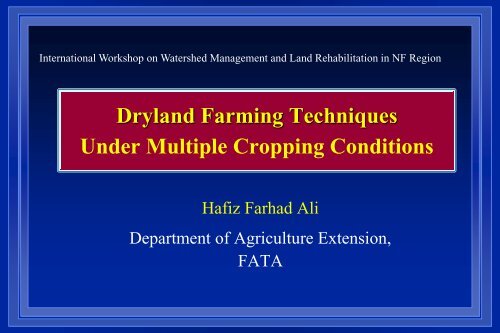Dryland Farming Techniques Under Multiple Cropping Conditions ...
Dryland Farming Techniques Under Multiple Cropping Conditions ...
Dryland Farming Techniques Under Multiple Cropping Conditions ...
- No tags were found...
Create successful ePaper yourself
Turn your PDF publications into a flip-book with our unique Google optimized e-Paper software.
District map of Khyber Pakhtunkhwa and FATA
AGRO-ECOLOGICAL ZONES OF KPK
<strong>Dryland</strong> farming techniques• Limited water resources in the North West Frontier of Pakistanrestricted in intensive crop production• Water saving approaches must be adopted in order to keepsustainable crop production
• Choosing proper methods of sowing and sowing your crops inappropriate date• Mulching fields with crop residues or plastic film for reducingwater losses from soil• Collecting water from rainfall for irrigation• Using chemical products to increase water use efficiency ofcrops
DEEP TILLAGE
PLASTIC MULCHING
PLANTS RESIDUE MULCH
Summary• <strong>Multiple</strong> cropping is one of the best ways of using solar radiation,rainwater and farmland efficiently to produce more crops underlimited season• Selection of cropping patterns, appropriate crops, and cropcombinations depends mainly on the local climate, soil conditions,and water availability• Winter wheat-summer maize double cropping system is the majorcropping pattern in The North West Frontier of Pakistan• Success of dryland farming is dependent upon the rainfall patterns• The basic idea for dryland farming is to store more rainwater in thesoil, to reduce water losses from the soil, and to make an efficientlyuse of soil water by crop plants
WE WANT PEACE IN THE WORLD
Smash corn plantsStraw-smashed field
Sowing winter wheatWheat-over wintering
Drought in Early Spring 2009 in some parts ofthe World
Major Planting Patterns• Winter wheat-summer maize• Intercropping of maize –soybean after winter wheat• Intercropping of maize –peanut after winter wheat• Intercropping of maize –vegetables after winter wheat• Relay cropping of winter wheat-cotton
Re-growth in springGrain filling
Wheat harvestingSowing summer maize
Maize growth during summerReady for pick up in autumn
DecSepMarJun
Reduce transpirationRainfallReduce evaporationReduce runoffStore more water in the soil
<strong>Multiple</strong> <strong>Cropping</strong>In The North West Frontier of Pakistan
Mad grain-----Is grain-shortage crisis coming ?• Grain producing countries decreased grain export• More than 40 countries involved in political troublesbecause of grain shortage
• More grains were used for producing bio-energy• Grain price increased rapidly
Artificial Rainfall
• The production of crops is usually spread over a longer period ofthe year, allowing for better vegetative cover to protect the soil• <strong>Multiple</strong> cropping reduced the risk of total loss from drought,pests and diseases. Usually at least some of the crops can escapedisaster and produce a yield
• The family has a more diverse supply of food and more than onesource of income• Systems with more than one crop frequently make better use oftotal sunlight, water, and available nutrients than is possible witha single crop
• It optimizes production from small plots, so can help farmerscope with land shortages• Including legumes in the cropping pattern helps maintain soilfertility by fixing nitrogen in the soilWheat-soybean
• It suppresses weeds. As the planting density is high, weeds cannotcompete with the crops.• Different types of crops can be planted to take advantage ofenvironmental factors in different seasons.• For example, crops that require a lot of water can be grown in thewet season, intercropped with drought-resistant crops that can beharvested in the following dry season.
Disadvantages• The presence of crops in the field throughout the year allows croppests to survive more easily.• Some pests can shift from one crop to another: for example, aphidscan move to cotton plants during the dry season.• The large number of different crops in the field makes it difficult toweed especially for the mixed cropping.• It may be difficult to introduce new techniques such as rowplanting, modern weeding tools, and improved varieties.• The harvest of crops is usually spreading throughout the year.
Major Patterns of <strong>Multiple</strong> <strong>Cropping</strong> in TheNorth West Frontier of Pakistan• The appropriate crops, crop combinations, planting times andplanting patterns vary from place to place• It depends on the local climate, soils, topography, wateravailability, pests and diseases, socio-economic conditions, andother factors.
Maize-potatoTobacco-PeanutMaize-Soybean
• Sequential cropping can be regard as multiple crops in “time”, i.e.two or three crops were planted sequentially with no overlap ingrowth cycle e.g, Winter wheat-summer maize double croppingsystem.Winter wheatSummer maize
• Intercropping : multiple crops in “space”, two or morecrops are planted in strips at the same time with theirsignificant parts of growth cycles overlappedWheat-cottonmaize-flax
• Mixed cropping: multiple crops in “space”, two or more crops areplanted in mixture at the same time with their significant parts ofgrowth cycles overlapped• Mixed cropping of maize, sorghum, millet, and cowpea
• Relay cropping: planting second crop before the harvest of the firstcrop• <strong>Multiple</strong> cropping is suitable for small scale farms or fields• <strong>Multiple</strong> cropping has been applied in crop production for morethan 1000 years in KPK
Maize-Maize
AdvantagesWhy multiple cropping?• More crops can be planted in a small space• Intercropping and relay cropping can allow a farmer to plant twoor more crops in the field at the same time
Hafiz Farhad Ali• Asstt: Director Food:Department of AgricultureExtension, FATA• Ph.D Scholar:Agricultural University, Peshawar, KPK• Email:hafizfarhad66@yahoo.com
















